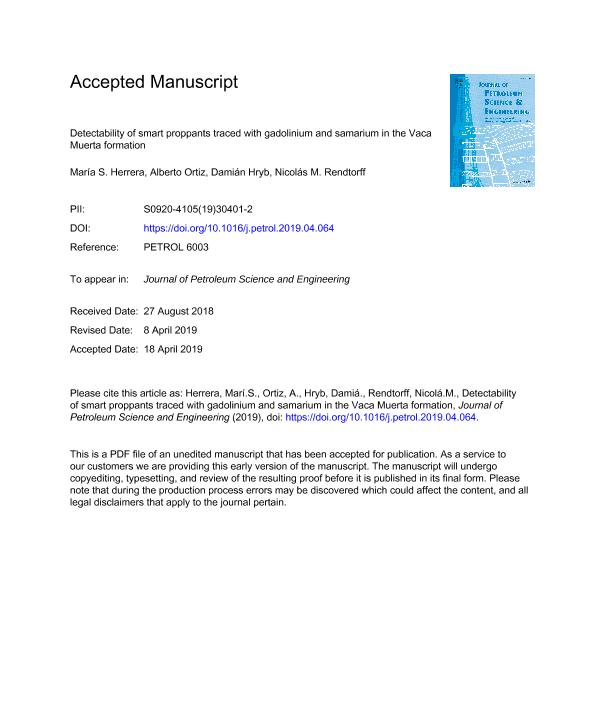Mostrar el registro sencillo del ítem
dc.contributor.author
Herrera, Maria Silvia

dc.contributor.author
Ortiz, Alberto
dc.contributor.author
Hryb, Damián
dc.contributor.author
Rendtorff Birrer, Nicolás Maximiliano

dc.date.available
2021-03-15T19:02:37Z
dc.date.issued
2019-08
dc.identifier.citation
Herrera, Maria Silvia; Ortiz, Alberto; Hryb, Damián; Rendtorff Birrer, Nicolás Maximiliano; Detectability of smart proppants traced with gadolinium and samarium in the Vaca Muerta formation; Elsevier Science; Journal Of Petroleum Science And Engineering; 179; 8-2019; 312-320
dc.identifier.issn
0920-4105
dc.identifier.uri
http://hdl.handle.net/11336/128344
dc.description.abstract
The use of smart proppants traced with gadolinium and samarium was evaluated in a realistic model by Monte Carlo simulations.The addition of compounds with high thermal neutron capture cross section, such as gadolinium oxide (Gd2O3) and samarium oxide (Sm2O3) into ceramic proppants, makes them detectable after placement in induced fractures.Proppants traced with different oxide concentrations were studied in a generic borehole-formation-tool configuration, modeled with MCNP. The Vaca Muerta formation model was constructed based on measured geochemical data. A theoretical formation of water-saturated limestone with 20% porosity was also used as a reference case of study. The minimum concentration of gadolinium and samarium oxides needed, in order to make them detectable by logging tools, was determined. In the case of gadolinium, results are in agreement with previous reported values for Gd2O3 addition of about 0.4% by weight of proppant.In the case of samarium, a minimum concentration of 1.25% by weight of Sm2O3 addition could be detected in both Limestone and Vaca Muerta formations.
dc.format
application/pdf
dc.language.iso
eng
dc.publisher
Elsevier Science

dc.rights
info:eu-repo/semantics/openAccess
dc.rights.uri
https://creativecommons.org/licenses/by-nc-sa/2.5/ar/
dc.subject
2010 MSC
dc.subject
65C05
dc.subject
82D75
dc.subject
GADOLINIUM OXIDE
dc.subject
MCNP
dc.subject
SAMARIUM OXIDE
dc.subject
THERMAL NEUTRON CAPTURE CROSS SECTION
dc.subject
TRACEABLE PROPPANT
dc.subject
VACA MUERTA FORMATION
dc.subject.classification
Otras Ingenierías y Tecnologías

dc.subject.classification
Otras Ingenierías y Tecnologías

dc.subject.classification
INGENIERÍAS Y TECNOLOGÍAS

dc.title
Detectability of smart proppants traced with gadolinium and samarium in the Vaca Muerta formation
dc.type
info:eu-repo/semantics/article
dc.type
info:ar-repo/semantics/artículo
dc.type
info:eu-repo/semantics/publishedVersion
dc.date.updated
2020-11-20T18:09:47Z
dc.journal.volume
179
dc.journal.pagination
312-320
dc.journal.pais
Países Bajos

dc.journal.ciudad
Amsterdam
dc.description.fil
Fil: Herrera, Maria Silvia. YPF - Tecnología; Argentina
dc.description.fil
Fil: Ortiz, Alberto. YPF - Tecnología; Argentina
dc.description.fil
Fil: Hryb, Damián. YPF - Tecnología; Argentina
dc.description.fil
Fil: Rendtorff Birrer, Nicolás Maximiliano. Provincia de Buenos Aires. Gobernación. Comisión de Investigaciones Científicas. Centro de Tecnología de Recursos Minerales y Cerámica. Consejo Nacional de Investigaciones Científicas y Técnicas. Centro Científico Tecnológico Conicet - La Plata. Centro de Tecnología de Recursos Minerales y Cerámica; Argentina
dc.journal.title
Journal Of Petroleum Science And Engineering

dc.relation.alternativeid
info:eu-repo/semantics/altIdentifier/url/https://linkinghub.elsevier.com/retrieve/pii/S0920410519304012
dc.relation.alternativeid
info:eu-repo/semantics/altIdentifier/doi/https://doi.org/10.1016/j.petrol.2019.04.064
Archivos asociados
